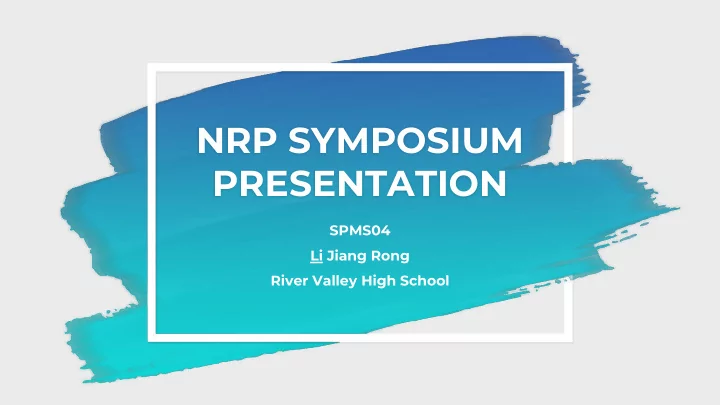

NRP SYMPOSIUM PRESENTATION SPMS04 Li Jiang Rong River Valley High School
Spin Orbit Torque-Based Synaptic Devices in an Artificial Neural Network 2
1. RATIONALE Significance of Project
SMALLER devices with HIGHER data density Conventional Spintronics Electronics 8-Bit Data VS 1 1 1 1 1 1 1 1 00000000 4
INCREASING power consumption Transistors Power 5
2. AIMS Objectives of Project 6
Device Size Dependence Device Size No. of Resistance States (100 nm – 800 nm) 7
Hopfield Network Character Recognition Simulation of SOT devices 8
3. METHODOLOGY Experimental Procedures (Device Size Dependence) 9
1 2 SOT Devices (Device Size Dependence) 10
1 Magnetron Electron Beam Ion Milling Sputtering Lithography (Device Size Dependence) 11
1 Ta [ [ [Co/Pt] 4 Ta [ [ Si/SiO 2 Substrate Magnetron Electron Beam Ion Milling Sputtering Lithography (Device Size Dependence) 12
1 Electron Beam Exposure Positive Resist Substrate Substrate Substrate Negative Resist Substrate Substrate Substrate Magnetron Electron Beam Ion Milling Sputtering Lithography (Device Size Dependence) 13
1 Removing material to a desired depth (17.2 nm) Substrate Magnetron Electron Beam Ion Milling Sputtering Lithography (Device Size Dependence) 14
2 Computer Arduino with to control LabVIEW motor programme Field-Induced & Electromagnets Current-Induced Sample Keithley 2400 source meter to Motor with 1.8 ° send I write pulses rotation step size (Device Size Dependence) 15
2 Field-Induced & Current-Induced (Device Size Dependence) 16
4. RESULTS ANALYSIS Discussion of Project (Device Size Dependence) 17
Field-Induced c) d) a) b) 7 ( ( o ) o ) ( o ) ) ( 8 7 9 93.6 93.6 6 93.6 93.6 91.8 91.8 7 6 91.8 91.8 8 90.0 90.0 5 88.2 90.0 6 88.2 88.2 5 86.4 88.2 4 86.4 86.4 7 84.6 86.4 5 4 3 6 R H ( ) R H ( ) R H ( ) R H ( ) 4 3 2 5 3 2 1 2 1 4 0 1 0 3 -1 0 -1 -2 2 -8 -6 -4 -2 0 2 4 6 8 -8 -6 -4 -2 0 2 4 6 8 -8 -6 -4 -2 0 2 4 6 8 -8 -6 -4 -2 0 2 4 6 8 e) g) H (kOe) f) H (kOe) H (kOe) h) H (kOe) 9 7 9 ( ) ( ) ) ( ) ( 9 8 93.6 93.6 8 93.6 93.6 6 8 91.8 91.8 91.8 91.8 7 7 90.0 90.0 90.0 5 90.0 7 88.2 88.2 88.2 88.2 6 6 86.4 4 86.4 86.4 6 86.4 5 5 5 3 R H ( ) R H ( ) R H ( ) R H ( ) 4 4 4 2 3 3 3 1 2 2 2 0 1 1 1 -1 0 0 0 -8 -6 -4 -2 0 2 4 6 8 -10 -8 -6 -4 -2 0 2 4 6 8 10 -8 -6 -4 -2 0 2 4 6 8 -8 -6 -4 -2 0 2 4 6 8 H (kOe) H (kOe) H (kOe) H (kOe) (Device Size Dependence) 18
Current-Induced 1.4 a) c) b) d) 0.8 0.6 -2.4 1.2 0.6 0.4 -2.6 1.0 0.4 0.2 -2.8 0.8 0.2 R H ( ) R H ( ) R H ( ) R H ( ) 0.0 0.0 0.6 -3.0 -0.2 0.4 -0.2 -3.2 -0.4 0.2 -0.4 -3.4 -0.6 0.0 -0.6 -3.6 -0.8 -0.2 -1.5 -1.0 -0.5 0.0 0.5 1.0 1.5 -1.5 -1.0 -0.5 0.0 0.5 1.0 1.5 -1.5 -1.0 -0.5 0.0 0.5 1.0 1.5 -1.5 -1.0 -0.5 0.0 0.5 1.0 1.5 7 A/cm 2 ) 7 A/cm 2 ) 7 A/cm 2 ) 7 A/cm 2 ) J (10 J (10 J (10 J (10 1.0 1.6 g) f) h) e) 0.8 1.4 0.8 1.4 0.6 1.2 0.6 1.2 0.4 1.0 0.4 1.0 0.2 0.8 0.2 0.8 R H ( ) R H ( ) R H ( ) R H ( ) 0.0 0.0 0.6 0.6 -0.2 -0.2 0.4 0.4 -0.4 -0.4 0.2 0.2 -0.6 -0.6 0.0 0.0 -0.8 -0.8 -0.2 -1.5 -1.0 -0.5 0.0 0.5 1.0 1.5 -1.5 -1.0 -0.5 0.0 0.5 1.0 1.5 -1.5 -1.0 -0.5 0.0 0.5 1.0 1.5 -1.5 -1.0 -0.5 0.0 0.5 1.0 1.5 7 A/cm 2 ) 7 A/cm 2 ) 7 A/cm 2 ) 7 A/cm 2 ) J (10 J (10 J (10 J (10 (Device Size Dependence) 19
3. METHODOLOGY Experimental Procedures (Hopfield Network) 20
1 450 400 350 Number of Synapses 300 250 200 150 100 50 0 0 5 10 15 20 25 30 Number of Neurons 300 synapses needed in a 5x5 block pattern (Hopfield Network) 21
2 SOT devices as synaptic weights (Hopfield Network) 22
3 2 12 10 8 6 1 4 2 (a.u.) R H ( ) 0 -2 0 -4 -6 -8 -10 -1 -12 -15 -10 -5 0 5 10 15 7 A/cm 2 ) J (10 SOT devices as synaptic weights (Hopfield Network) 23
4. RESULTS ANALYSIS Discussion of Project (Hopfield Network) 24
Hopfield Network 3 Character recognition of letters ‘R’, ‘V’, ‘H’ and ‘S’ (Hopfield Network) 25
Hopfield Network 3 Character recognition of letters ‘R’, ‘V’, ‘H’ and ‘S’ (Hopfield Network) 26
5. CONCLUSION Future Implications of Project 27
Engineer devices with specific switching characteristics • Work towards energy-efficient brain-inspired computing • 28
References 1. Kurenkov, C. Zhang, S. DuttaGupta, S. Fukami, H. Ohno. (March, 2017). Device-size dependence of field-free spin-orbit torque induced magnetization switching in antiferromagnet/ferromagnet structures. Applied Physics Letters, 110, 092410. 2. William A. Borders, Hisanao Akima et al. (December, 2016). Analogue spin-orbit torque device for artificial-neural-network-based associative memory operation.Applied Physics Express 10, 013007. 29
THANK YOU! 30
Recommend
More recommend